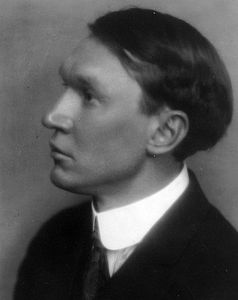Analysis of The Flower-Fed Buffaloes
Vachel Lindsay 1879 (Springfield) – 1931 (Springfield)
The flower-fed buffaloes of the spring
In the days of long ago,
Ranged where the locomotives sing
And the prarie flowers lie low:
The tossing, blooming, perfumed grass
Is swept away by wheat,
Wheels and wheels and wheels spin by
In the spring that still is sweet.
But the flower-fed buffaloes of the spring
Left us long ago,
They gore no more, they bellow no more:--
With the Blackfeet lying low,
With the Pawnee lying low.
| Scheme | ABABCDEDABFBB |
|---|---|
| Poetic Form | |
| Metre | 01011101 0011101 1100101 0011011 01010011 110111 1010111 0011111 101011101 11101 111111011 101101 1011101 |
| Closest metre | Iambic tetrameter |
| Characters | 419 |
| Words | 79 |
| Sentences | 3 |
| Stanzas | 1 |
| Stanza Lengths | 13 |
| Lines Amount | 13 |
| Letters per line (avg) | 26 |
| Words per line (avg) | 6 |
| Letters per stanza (avg) | 333 |
| Words per stanza (avg) | 76 |
Font size:
Submitted on May 13, 2011
Modified on March 14, 2023
- 23 sec read
- 477 Views
Citation
Use the citation below to add this poem analysis to your bibliography:
Style:MLAChicagoAPA
"The Flower-Fed Buffaloes" Poetry.com. STANDS4 LLC, 2024. Web. 27 Apr. 2024. <https://www.poetry.com/poem-analysis/37364/the-flower-fed-buffaloes>.


Discuss this Vachel Lindsay poem analysis with the community:
Report Comment
We're doing our best to make sure our content is useful, accurate and safe.
If by any chance you spot an inappropriate comment while navigating through our website please use this form to let us know, and we'll take care of it shortly.
Attachment
You need to be logged in to favorite.
Log In